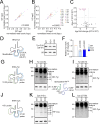This is a preprint.
TRMT1L-catalyzed m2 2G27 on tyrosine tRNA is required for efficient mRNA translation and cell survival under oxidative stress
- PMID: 39416027
- PMCID: PMC11482778
- DOI: 10.1101/2024.05.02.591343
TRMT1L-catalyzed m2 2G27 on tyrosine tRNA is required for efficient mRNA translation and cell survival under oxidative stress
Update in
-
TRMT1L-catalyzed m22G27 on tyrosine tRNA is required for efficient mRNA translation and cell survival under oxidative stress.Cell Rep. 2025 Jan 28;44(1):115167. doi: 10.1016/j.celrep.2024.115167. Epub 2025 Jan 8. Cell Rep. 2025. PMID: 39786998 Free PMC article.
Abstract
tRNA modifications are critical for several aspects of their functions, including decoding, folding, and stability. Using a multifaceted approach encompassing eCLIP-seq and Nanopore tRNA-seq, we show that the human tRNA methyltransferase TRMT1L interacts with component of the Rix1 ribosome biogenesis complex and binds to the 28S rRNA, as well as to a subset of tRNAs. Mechanistically, we demonstrate that TRMT1L is responsible for catalyzing m2 2G solely at position 27 of tRNA-Tyr-GUA. Surprisingly, TRMT1L depletion also impaired the deposition of acp3U and dihydrouridine on tRNA-Tyr-GUA, Cys-GCA, and Ala-CGC. TRMT1L knockout cells have a marked decrease in tRNA-Tyr-GUA levels, coinciding with a reduction in global translation rates and hypersensitivity to oxidative stress. Our results establish TRMT1L as the elusive methyltransferase catalyzing the m2 2G27 modification on tRNA Tyr, resolving a long-standing gap of knowledge and highlighting its potential role in a tRNA modification circuit crucial for translation regulation and stress response.
Keywords: N2, N2-dimethylguanosine (m22G); Nanopore tRNA-seq; RNA methyltransferases; TRMT1L; eCLIP-seq; oxidative stress response; rRNA; tRNA; translation.
Conflict of interest statement
DECLARATION OF INTERESTS The authors declare no competing interests.
Figures







References
Publication types
Grants and funding
LinkOut - more resources
Full Text Sources
Molecular Biology Databases
Miscellaneous
